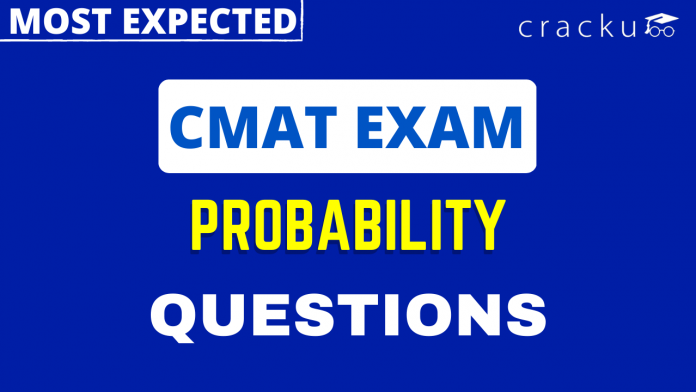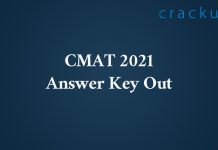CMAT Probability Questions [Download PDF]
Download Probability Questions for CMAT PDF – CMAT Probability questions PDF by Cracku. Practice CMAT solved Probability Questions paper tests, and these are the practice question to have a firm grasp on the Probability topic in the XAT exam. Top 20 very Important Probability Questions for CMAT based on asked questions in previous exam papers. Click on the link below to download the Probability Questions for CMAT PDF with detailed solutions.
Download Probability Questions for CMAT
Enroll to CMAT 2023 Crash Course
Question 1: A bag contains 6 red balls, 11 yellow balls and 5 pink balls. If two balls are drawn at a random from the bag, one after another. What is the probability that the first ball drawn was red and the second ball drawn was yellow in colour?
a) $\frac{3}{14}$
b) $\frac{5}{7}$
c) $\frac{1}{7}$
d) $\frac{1}{14}$
1) Answer (C)
Solution:
There are 6 red balls, 11 yellow balls and 5 pink balls
Total number of balls = 6 + 11 + 5 = 22
Probability of selecting red ball = $\frac{6}{22}$
After selecting one ball, there are 21 balls left
Probability of selecting yellow ball = $\frac{11}{21}$
Therefore, probability = $\frac{6}{22}\times\ \frac{11}{21}$ = $\frac{1}{7}$
Answer is option C.
Question 2: In a bag there are 15 red balls and 10 green balls. Three balls are selected at random. The probability of selecting 2 red balls and 1 green ball is :
a) $\frac{21}{46}$
b) $\frac{25}{117}$
c) $\frac{3}{25}$
d) $\frac{1}{50}$
2) Answer (A)
Solution:
Number of ways of selecting 2 red balls and 1 green ball = $15_{C_2}.\ 10_{C_1}$
Number of ways of selecting 3 balls = $25_{C_3}$
Probability of selecting 2 red balls and 1 green ball = $\ \frac{15_{C_2}.10_{C_1}}{25_{C_3}}$ = $\frac{21}{46}$
Answer is option A.
Question 3: The following five candidates have applied for a position in an organisation: Male 30 years, Male 32 years, Female 45 years, Female 20 years, and Male 40 years. What is the probability that the candidate selected for the position will be either female or over 35 years?
a) 4/5
b) 2/5
c) 1/5
d) 3/5
3) Answer (D)
Solution:
Female – A
above 35 years – B
n(A $\cup $ B ) = n(A)+n(B) – n (A $ \cap $ B) = 2 + 2 – 1 = 3
Probability = $\frac{3}{5}$
Answer is option D.
Question 4: In a class of 45 students, 25 are girls. In a test, 30 students scored above 90% marks and 18 of them are girl students. A student is selected at random. The probability of selecting a girl scoring above 90% marks is___________
a) 18/45
b) 12/45
c) 18/30
d) 30/45
4) Answer (A)
Solution:
It is given,
Total number of students = 45
Number of girls who scored above 90% marks = 18
Therefore, probability = $\frac{18}{45}\ $
Answer is option A.
Question 5: In a charity show, tickets numbered consecutively from 101 through 350 are placed in a box. What is the probability that a ticket selected randomly will have a number with a hundredth digit as two?
a) 100/250
b) 99/249
c) 100/249
d) 99/250
5) Answer (A)
Solution:
350 = 101 + (n-1)1
n = 250
Total number of tickets = 250
There are 100 tickets(200 to 299) between the tickets 101 and 350 whose hundredth digit is 2.
Probability = $\ \frac{100}{250}$
Answer is option A.
Question 6: What is the probability that a leap year has 53 Sundays and 53 Mondays?
a) 2/7
b) 1
c) 0
d) 1/7
6) Answer (D)
Solution:
Number of days in leap year = 366
There are 2 odd days in a leap year. For a year to have 53 sundays and 53 mondays, 2 odd days should be sunday and monday.
This is only possible when the first day of the year is sunday.
Therefore, the probability of the first day is sunday = $\frac{1}{7}$
Answer is option D.
Question 7: There is a shooting event organised by the SBT youth Club to select the best candidate who will qualify to participate in Eklavya championship. The shooting board is designed by using 4 concentric circles of radii 2 inch, 3 inch, 5 inch and 9 inch. What is the probability that the participant will shoot only in the second ring [from the outside] to qualify for Eklavya championship.
a) $\frac{16}{25}$
b) $\frac{20}{81}$
c) $\frac{20}{56}$
d) $\frac{16}{81}$
7) Answer (D)
Solution:
The board is as follows.
.png)
The required probability = $\frac{\pi\left(5\right)^2-\pi\left(3\right)^2}{\pi\left(9\right)^2}=\frac{25-9}{81}=\frac{16}{81}$
Hence, the answer is option D.
Question 8: An unbiased dice is tossed seven times. Find the probability of getting a third six on the seventh throw.
a) $\frac{\left(^6C_2\times\ 5^2\right)}{6^7}$
b) $\frac{\left(^6C_2\times\ 5^4\right)}{6^7}$
c) $\frac{\left(^6C_3\times\ 5^3\right)}{6^7}$
d) $\frac{\left(^7C_3\times\ 5^4\right)}{6^7}$
8) Answer (B)
Solution:
We need a third 6 in the 7th throw which means that in the first 6 throws we should get 6 exactly twice.
No. of ways of getting 6 exactly twice in first 6 throws= $^6C_2$
Probability of getting 6 for the third time in the seventh throw= $\frac{\left(^6C_2\times\ 5^4\right)}{6^7}$
Question 9: Ishika speaks truth in 60% of cases and Mishika in 85% of cases. Ishika and Mishika agree in astatement. Find the probability that the statement is true.
a) $\frac{49}{57}$
b) $\frac{51}{100}$
c) $\frac{57}{100}$
d) $\frac{51}{57}$
9) Answer (D)
Solution:
For both Ishika and Mishika to agree on a statement either both have to speak the truth or both have to speak false.
Probability of both speaking truth = (60/100)*(85/100) = 204/400
Probability of both speaking false = (40/100)*(15/100) = 24/400
The probability that the statement is true when Ishika and Mishika both agree on a statement = (204/400)/{(204/400)+(24/400)} = 204/228 = 51/57
Question 10: An article manufactured by a company consists of two parts: Part I and Part II. In theprocess of manufacturing of Part I, 9 products out of 100 are likely to be defective.Similarly, 5 products out of 100 are likely to be defective in the manufacture of Part II.What is the probability that the final assembled article will NOT be defective?
a) 0.8465
b) 0.8645
c) 0.8564
d) 0.8546
10) Answer (B)
Solution:
Probability to be defective for part I = $\frac{9}{100}$
Probability to be defective for part II = $\frac{5}{100}$
Final assembled problem will not be defective if part I and part II are not defective.
Probability = $\frac{91}{100}\times\ \frac{95}{100}$ = 0.8645
Answer is option B.
Question 11: During the next year, the probability that a Company A releases a mobile is 0.7. The probability that mobile is a success. given that it is released by the Company is 0.8. The probability that a mobile is a success and released by a Company B is 0.28. A mobile released by either Company A or Company B during the next one year is a success. Find the probability that it is released by Company A.
a) $\frac{1}{3}$
b) $\frac{1}{2}$
c) $\frac{2}{3}$
d) $\frac{3}{4}$
11) Answer (C)
Solution:
Probability that A releases a mobile = 0.7
Probability that mobile is a success given that it is released by A = 0.8
Probability that mobile is released by A and is success = 0.8*0.7 = 0.56
And probability that mobile is a success and released by B = 0.28
Total probability for success = 0.56+0.28 = 0.84
Now Probability that it is success and is released by A = 0.56/0.84 = 2/3
Question 12: A small store has five units of a new phone model in stock: two white, two black, and one red. Three customers arrive at the shop to buy a unit each. Each one has a pre- determined choice of the colour and will not buy a unit of any other colour. All the three customers are equally likely to have chosen any of the three colours. What is the probability that the store will be able to satisfy all the three customers?
a) $\frac{4}{5}$
b) $\frac{7}{9}$
c) $\frac{2}{3}$
d) $\frac{8}{9}$
e) $\frac{1}{3}$
12) Answer (C)
Solution:
Number of white phones = 2
Number of black phones = 2
Number of red phones = 1
customer 1 will have 3 choices
customer 2 will have 3 choices
customer 3 will have 3 choices
Hence total choices = 3 x 3 x 3 = 27
The cases not possible = BBB, RRR,WWW, RRB,RBR,BRR, RRW,RWR, WRR
Possible cases = 18
Probability = 18/27 = 2/3
Question 13: Brother and sister both appear for an interview. The probability of the selection of brother is $\frac{1}{8}$ while the probability of rejection of sister is $\frac{4}{5}$ What is the probability that only one of them is selected ?
a) $\frac{11}{40}$
b) $\frac{7}{40}$
c) $\frac{5}{13}$
d) $\frac{1}{10}$
13) Answer (A)
Solution:
Probability of brother’s selection = $\frac{1}{8}$ and probability of brother’s rejection = $\frac{7}{8}$
Probability of sister’s selection = $\frac{1}{5}$ and probability of sister’s rejection = $\frac{4}{5}$
Probability that only one of them is selected = (prob. that brother is selected) × (prob. that sister is not selected) + (Prob. that brother is not selected) × (Prob. that sister is selected)
= $(\frac{1}{8})(\frac{4}{5})+(\frac{7}{8})(\frac{1}{5})$
= $\frac{4}{40}+\frac{7}{40}=\frac{11}{40}$
=> Ans – (A)
Question 14: Ashok has a bag containing 40 cards, numbered with the integers from 1 to 40. No two cards are numbered with the same integer. Likewise, his sister Shilpa has another bag containing only five cards that are numbered with the integers from 1 to 5, with no integer repeating. Their mother, Latha, randomly draws one card each from Ashok’s and Shilpa’s bags and notes down their respective numbers. If Latha divides the number obtained from Ashok’s bag by the number obtained from Shilpa’s, what is the probability that the remainder will not be greater than 2?
a) 0.8
b) 0.91
c) 0.73
d) 0.94
e) 0.87
14) Answer (E)
Solution:
The number of ways of selecting one card from Ashok’s bag and other from Shilpa bag = $40_{C_1}\times\ 5_{C_1}$ = 200
Now, if the card taken from Shilpa’s bag shows 1, then 1 will divide all the numbers on Ashok’s card. Hence, the number of ways = 40
If the card taken from Shilpa’s bag shows 2, then the remainder will be either 0 or 1. Hence, the number of ways = 40
If the card taken from Shilpa’s bag shows 3, then the remainder will be 0, 1 or 2. Hence, the number of ways = 40
If the card taken from Shilpa’s bag shows 4, then the remainder will be 0, 1, 2 or 3. So the numbers having 3 as remainder will be rejected. So the number of form 4n+3 will be rejected. Total number of such numbers = $\frac{\left(39-3\right)}{4}+1$ = 10
If the card taken from Shilpa’s bag shows 5, then the remainder will be 0, 1, 2, 3 or 4. So the numbers having 3 or 4 as remainder will be rejected. So the number of form 5n+3, 5n+4 will be rejected. Total number of such terms = $\frac{\left(39-3\right)}{4}+1$ = 10
The numbers left = 40-10 = 30
The total numbers having 5n+3 form = $\frac{\left(39-4\right)}{5}+1\ =\ 8$
The total numbers having 5n+4 form = $\frac{\left(38-3\right)}{5}+1\ =\ 8$
The numbers left = 40-8-8=24
Hence, the probability = $\frac{\left(40+40+40+30+24\right)}{200}=\frac{174}{200}=0.87$
Question 15: If Swamy has two children and he truthfully answers yes to the question “Is at least one of your children a girl?” what is the probability that both his children are girls?
a) $\frac{1}{2}$
b) $\frac{1}{3}$
c) 1
d) 0
15) Answer (A)
Solution:
Probability = $\frac{\left(Number\ of\ favourable\ cases\right)}{Total\ number\ of\ cases}$
Here the possible outcomes are GG or GB
So probability of two girls = 1/2
Question 16: There are 6 tickets to the theater, four of which are for seats in the front row. 3 tickets are selected at random. What is the probability that two of them are for the front row?
a) 0.6
b) 0.7
c) 0.9
d) $\frac{1}{3}$
16) Answer (A)
Solution:
Out of all the 6 tickets, 4 are front row tickets and the rest 2 are not.
Out of 4 front tickets 2 can be selected in $^{4\ }C\ _2$
The remaining 1 ticket has to be selected in $^{2\ }C\ _1$
Hence total ways of selecting 3 tickets such that 2 of them are front row are $^{4\ }C\ _2$ * $^{2\ }C\ _1$
3 out of 6 tickets can be selected in $^{6\ }C\ _3$ ways.
Required probability = $^{4\ }C\ _2$ * $^{2\ }C\ _1$ / $^{6\ }C\ _3$
Which is equal to 0.6
Question 17: A five digit number is formed by using the digits 1, 2, 3, 4 and 5 without repetitions. What is the probability that the number is divisible by 4?
a) $\frac{1}{5}$
b) $\frac{5}{6}$
c) $\frac{4}{5}$
d) None of these
17) Answer (A)
Solution:
For a number to be divisible by 4, last 2 digits must be divisible by 4
Last 2 digits can be 12, 24, 32, 52
_, _, _, _, _
Last 2 digits have 4 possibilities and remaining digits can be arranged in 3! ways
Number of 5 digit numbers divisible by 4 are 3! $\times\ $ 4 = 24
Total number of 5 digit numbers that can be formed = 5!
Therefore, probability = $\frac{24}{5!}\ $ = $\frac{1}{5}$
Answer is option A.
Question 18: A special lottery is to be held to select a student who will live in the only deluxe room in a hostel. There are 100 Year- Ill, 150 Year-II, and 200 Year-I students who applied. Each Year-III’s name is placed in the lottery 3 times; each Year-II’s name, 2 times; and each Year-I’s name, 1 time. What is the probability that a Year-III’s name will be chosen?
a) $\frac{1}{8}$
b) $\frac{2}{9}$
c) $\frac{2}{7}$
d) $\frac{3}{8}$
18) Answer (D)
Solution:
By the given information,
Total number of Year III student’s name= 3*100= 300
Total number of Year II student’s name= 2*150= 300
Total number of Year I student’s name= 1*200= 200.
Number of favourable outcomes= year III student’s name= 300
Total Sample space= total number of names= 300+300+200= 800.
Therefore, required probability= $\ \frac{\ 300}{800}=\ \ \frac{\ 3}{8}$- Option D
Question 19: Thirty days are in September, April, June and November. Some months are of thirty one days. A month is chosen at random.
Then its probability of having exactly three days less than maximum of 31 is
a) $\frac{15}{16}$
b) 1
c) $\frac{3}{48}$
d) None of these
19) Answer (D)
Solution:
Number of days in February = 28
Number of months having three days less than 31 i.e, 28 days = 1
$\therefore\ $Required probability = $\frac{1}{12}$
Hence, the correct answer is Option D
Question 20: Sonal and Meenal appear in an interview for same post having two vacancies. If $\frac{1}{7}$ is Sonal’s probability of selection and $\frac{1}{5}$ is Meenal’s probability of selection then what is the probability that only one of them is selected?
a) $\frac{1}{7}$
b) $\frac{2}{7}$
c) $\frac{3}{5}$
d) $\frac{1}{5}$
20) Answer (B)
Solution:
Probability of Sonal’s selection = $\frac{1}{7}$
Probability of Meenal’s selection = $\frac{1}{5}$
The probability that only one of them is selected = $\frac{1}{7}$*$\frac{4}{5}$ + $\frac{6}{7}$*$\frac{1}{5}$
= $\frac{10}{35}$
= $\frac{2}{7}$
B is the correct answer.





